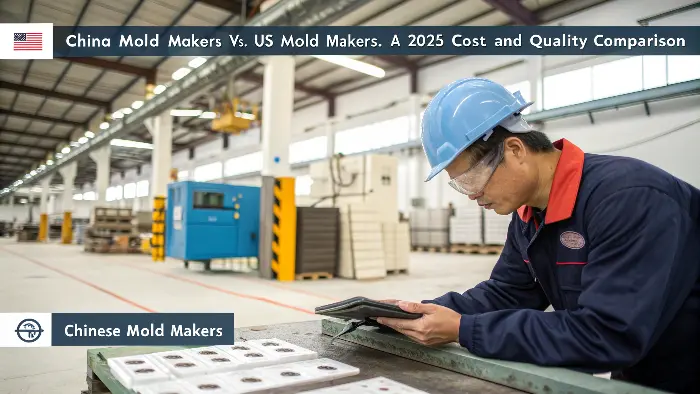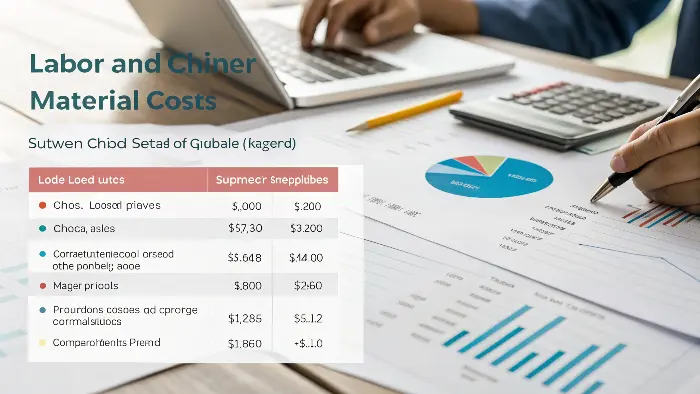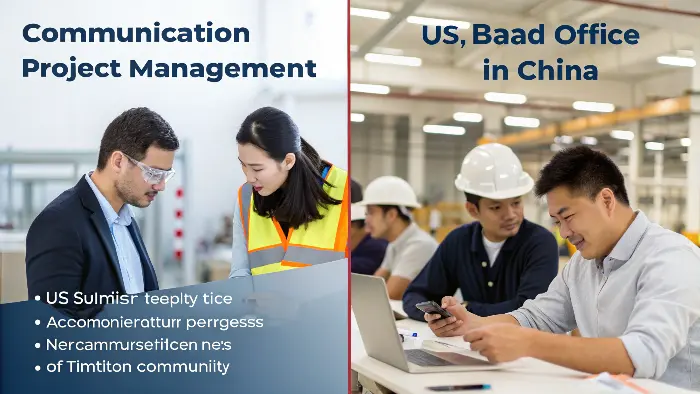Choosing a mold maker is one of the biggest decisions you’ll make for your product. You’re caught between the promise of cost savings from China and the perceived safety of a US supplier. This uncertainty can be stressful, as the wrong choice could derail your entire project schedule and budget, putting your reputation on the line.
In 2025, the best choice depends entirely on your project’s priorities. Chinese mold makers typically offer a 30-50% cost advantage due to lower labor and overhead, making them ideal for budget-sensitive projects. US makers often excel in projects requiring extreme complexity, rapid domestic turnaround, and ironclad IP protection. The key is to weigh cost against factors like lead time, quality assurance, and communication needs.

But the decision isn’t just about the sticker price. The true cost and value of a mold are measured over its entire lifecycle, from design to final production parts. Many factors beyond the initial quote will influence your project’s success. To make the right call, you need to look deeper at the specific strengths and weaknesses of sourcing from each region. Let’s break down the factors you need to consider to make the right choice for your next project.
How Do Labor and Material Costs Really Differ?
You see the low quotes from Chinese suppliers, but a part of you is skeptical. Are those savings real, or are they hiding something you’ll pay for later? You need to understand the true cost breakdown to budget accurately and avoid getting hit with unexpected fees for materials or design changes, which can turn a great deal into a financial headache.
The primary cost difference comes from labor rates, which are significantly lower in China. While the cost of high-quality mold steel is similar globally, China’s vast manufacturing ecosystem provides more competitive pricing on standard components, machining, and other overheads. This combination creates a substantial and genuine initial cost advantage for most projects sourced from a reputable Chinese mold maker.

When I talk to project managers like Alex in Australia, the first question is always about the bottom line. The cost difference is real, but it’s important to know where it comes from. It’s not about cutting corners on materials, at least not with a reputable supplier. It’s about fundamental economic differences in the manufacturing landscape.
The Labor Cost Advantage
The most significant factor is the cost of skilled labor. An experienced toolmaker or CNC operator in the US can command a high hourly wage, often between $50 and $100. In China, a similarly skilled technician might earn $10 to $20 per hour. This isn’t because the skill is less; it’s a reflection of the local economy and the vast pool of available talent. When a mold requires hundreds or even thousands of hours of work, this wage difference adds up to massive savings. This allows us at CavityMold to dedicate more man-hours to polishing and fitting without inflating the budget.
Material and Overhead Costs
For high-quality molds, we use the same steel no matter where the mold is made. Whether it’s P20, H13, or S136, we often import it from the same global suppliers like ASSAB or LKM. While there might be slight price variations due to local distribution, the raw material cost is largely comparable. The other savings come from overhead. Factory space, utilities, and administrative costs are all substantially lower in China. This lean operational structure allows us to pass those savings directly to our clients.
Here is a simplified table to illustrate the cost structure:
| Cost Factor | China Mold Maker | US Mold Maker |
|---|---|---|
| Skilled Labor Rate | $10 – $20 / hour | $50 – $100+ / hour |
| Standard Mold Steel | Marginally Lower | Global Market Price |
| Factory Overhead | Lower | Higher |
| Initial Quote | Typically 30-50% Lower | Higher |
Is the Quality Gap Between China and the US Closing?
You’ve probably heard stories about poor quality from overseas suppliers. It’s a common fear that saving money on a Chinese mold means sacrificing the precision, finish, and durability your product demands. A low-quality mold can fail prematurely or produce defective parts, costing you far more in maintenance, downtime, and scrap than you ever saved on the initial purchase.
Yes, the quality gap has not only closed but, in many cases, disappeared when working with top-tier Chinese suppliers. Reputable shops in China now use the same high-grade imported steel, advanced German and Japanese CNC machinery, and rigorous quality control processes as their US counterparts. The key is no longer country of origin but diligent supplier vetting to find a partner committed to international standards.

The idea of "Made in China" has changed dramatically over the last decade. The image of cheap, low-quality goods is outdated, especially in the technical field of mold making. As a company that has been in this business since 2009, I’ve witnessed this transformation firsthand. The best Chinese mold makers are now world-class, competing on quality, not just price.
Technology and Equipment
Walk into our facility, and you’ll see the same equipment you’d find in a top shop in Ohio or California. We’ve invested heavily in high-precision 5-axis CNC machines from Germany, advanced EDMs from Japan, and CMMs (Coordinate Measuring Machines) for meticulous inspection. Technology is a great equalizer. When we use the same machines and the same software (like SolidWorks or UG), we can achieve the same tight tolerances and complex geometries as any Western shop. The playing field, from a technology standpoint, is now level.
Standards and Expertise
Beyond the hardware, there has been a huge leap in expertise and process control. Most professional mold makers in China are ISO 9001 certified, which means our quality management systems are held to a global standard. Our engineers are highly skilled in mold flow analysis to predict and prevent injection issues before any steel is cut. I remember a project for a client in Germany who needed a complex medical device part with a mirror polish and tolerances of +/- 0.02mm. They were hesitant at first, but our detailed DFM (Design for Manufacturability) report and transparent process won them over. We delivered a mold that exceeded their expectations, proving that world-class quality is achievable anywhere with the right team.
The Importance of Vetting
The challenge is that quality can vary more widely in China. While the top tier is excellent, there are still many smaller, less-equipped shops. This is why the responsibility falls on you, the client, to perform due diligence. Don’t just look at the price. Ask for case studies, equipment lists, quality inspection reports, and client references. A good partner will be proud to share this information.
What Are the Hidden Costs of Sourcing Molds from China?
The initial quote from a Chinese supplier looks fantastic, but you have that nagging feeling you’re missing something. What other expenses are going to pop up later? Getting blindsided by shipping fees, import tariffs, or unexpected costs for revisions can quickly turn your budget-friendly project into a financial nightmare, causing stress and delays that you didn’t plan for.
The main hidden costs of sourcing from China include international shipping, import duties and taxes, and potential travel for on-site validation. You should also budget for communication delays that could lead to rework and the cost of third-party inspections if you can’t visit yourself. A transparent supplier will discuss these potential costs with you upfront to create a realistic total budget.

A low initial quote is only one part of the total cost of ownership. To get a true picture, you have to account for the expenses that come after the mold is built. I always advise my clients to think about these factors from the very beginning so there are no surprises down the road. A good partnership is built on transparency, and that includes being honest about all the potential costs involved.
Logistics and Tariffs
Shipping a multi-ton block of steel across the ocean isn’t cheap. You have to choose between sea freight, which is cost-effective but slow (3-5 weeks), and air freight, which is fast (a few days) but very expensive. You also need to factor in insurance and local transportation from the port to your facility. On top of that, you have to consider import tariffs and taxes. These can change based on government policy and can add a significant percentage to your total cost. A US-based maker eliminates these issues; shipping is just a domestic truck ride away.
Communication and Revisions
Time zone differences are a real factor. A question you ask at the end of your day might not get answered until you’re asleep, potentially adding a day to your timeline for every simple clarification. If a misunderstanding in the design phase leads to a mistake in the mold, the cost of rework—both in time and money—can be substantial. This is why we assign a dedicated, English-speaking project manager to every project, to act as a bridge and ensure communication is clear and constant.
IP Protection and Travel
Intellectual property protection is a valid concern. While it has improved greatly, the legal framework in the US is stronger. Working with a long-standing, reputable company with a track record of serving international clients is the best way to mitigate this risk. Finally, consider the cost of validation. If you want to be present for the mold trial (T1), flying to China is a significant expense in both time and money compared to driving a few hours to a local shop.
| Hidden Cost Factor | Sourcing from China | Sourcing from the US |
|---|---|---|
| Shipping | High (Air/Sea Freight) | Low (Domestic Trucking) |
| Tariffs & Duties | Applicable, can be significant | None |
| Communication Lag | Potential due to time zones | Minimal |
| On-site Visits | Expensive and time-consuming | Relatively cheap and easy |
| IP Risk | Higher, requires due diligence | Lower, strong legal protection |
How Do Communication and Project Management Compare?
To keep your project on track, you need constant updates and clear, unambiguous communication. You might worry that language barriers, cultural differences, and a 12-hour time difference will make managing a project with a Chinese supplier a constant struggle. Poor communication can easily lead to missed deadlines, incorrect specifications, and a final tool that doesn’t perform as needed.
US makers offer the clear advantage of a shared language and time zone, making real-time collaboration easy. However, professional Chinese suppliers have overcome this by implementing structured communication protocols. They provide a dedicated, fluent English-speaking project manager who delivers regular progress reports with photos and videos, ensuring you are always informed and in control of the process.

Effective project management is the backbone of successful mold making, regardless of location. The goal is to eliminate surprises and give you a clear view of your project’s progress at all times. The methods to achieve this may differ between a US and a Chinese partner, but the outcome should be the same: a high-quality mold, delivered on time.
The US Advantage: Proximity and Culture
There is no denying the ease of working with someone in your own country. You can pick up the phone and get an immediate answer. You can drive to their facility for a critical meeting or to inspect the mold firsthand. This is especially valuable for highly complex or iterative projects where constant, fluid collaboration is necessary. The shared cultural context and business practices also smooth out the process, reducing the chance of misunderstandings.
The Chinese Model: Structured Reporting
Top-tier Chinese firms like ours have built our business around serving international clients. We understand that we have to work harder to bridge the distance. That’s why we developed a system of hyper-transparent project management. When you work with us, you are assigned a single point of contact—an experienced project manager who is fluent in English. Every week, you receive a detailed progress report with high-resolution photos of your mold being machined. You get videos of every mold trial, so you can see the parts coming off the press. I once worked with Alex, a project manager from Australia. He was initially very concerned about the time difference. We set up a weekly video call that fit his morning schedule and provided daily email updates. After the project, he told me he felt more informed and in control than he had on some of his domestic projects because our process was so structured and transparent.
Conclusion
The choice between a Chinese and a US mold maker in 2025 isn’t about which country is "better." It’s about finding the right partner for your specific needs. The decision requires a careful balance of cost, quality, speed, and risk management. A vetted Chinese supplier offers unbeatable value for many projects, while a US maker provides advantages in speed and simplicity.
Ultimately, the best choice depends on your project’s unique priorities. At CavityMold, we strive to bridge the gap, offering the cost-effectiveness of Chinese manufacturing combined with the quality, communication, and reliability you’d expect from a top-tier domestic partner. Master your molding project by making the right choice from the start.
